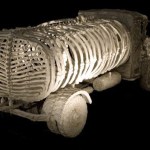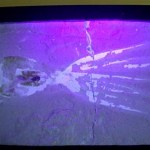fossil
Utah may seem like an odd place to search for primates, but you can find them if you know where to look. Although scrubby and arid today, between 46-42 million years ago what is now the northeastern part of the state was a lush forest which was home to a variety of peculiar fossil primates. Called omomyids, these relatives of living tarsiers are primarily known from teeth and associated bits and pieces of bone, but newly discovered postcranial remains may provide paleontologists with a better idea of how some of these ancient primates moved.
For most of their early evolution omomyids were…
Now that the details about Australopithecus sediba have been published, I am faced with an important question - how am I going to fit the new hominin into Written in Stone?
When I started composing Written in Stone I was determined to make it as up-to-date as possible. This was not only out of a concern for accuracy, but also stemmed from a desire to present the public with some discoveries that they may not have heard about before. Given that new paleontological papers are being published every week, however, I have often been faced with the question of how to incorporate interesting new…
The partial faces of Anoiapithecus (left), Pierolapithecus (center), and Dryopithecus (right). (Images not to scale)
Our species is just one branch of a withering part of the evolutionary tree, the great apes. Along with the handful of species of chimpanzees, gorillas, and orangutans, we are all that is left of the hominids, and considering the threats our close relatives face we could very soon be the only great apes left. It has not always been this way. During the swath of prehistory ~23-5 million years ago known as the Miocene a variety of ape species inhabited forests through much of…
I'll be the first to admit it; the specimen was not much to look at. Seventy years after being dug out of the ground much of it had crumbled into four-foot-long Y, and the curved teeth that once stood upright in that jaw had slumped out of their sockets into the sulfur-smelling debris. All the same, it was an impressive sight.
During the past four years I have spent much of my free time reading about evolution and paleontology. Popular summaries, symposium volumes, technical papers; the numerous books that clutter my office and the disorganized mess of PDFs on my hard drive have taught me…
The skeleton of an elk-moose (Cervalces scotti), photographed at the New Jersey State Museum.
A photograph and line drawing (left side) of the fossil dolphin Astadelphis gastaldii. The crescent-shaped line in the line drawing represents the bite of a large shark, with the red portions representing damage done directly to the bone. From Bianucci et al, 2010.
Shark attacks are events of speed and violence. When they have locked on to a prey item sharks seem to come out of nowhere, and though they can be quite gentle with their jaws (as on occasions when they are unsure about whether something is food or not) their ranks of serrated teeth can inflict a devastating amount of damage.…
When it comes to aliens, Hollywood really does not have much imagination. Most extraterrestrials that have appeared on the big screen look very much like us, or are at least some kind of four-to-six-limbed vertebrate, and this says more about out own vanity than anything else. It would be far more interesting, I think, to take the weird and wonderful organisms of the Cambrian as inspiration for alien life forms, and two new critters have just been added to the odd Cambrian menagerie.
A restoration of Herpetogaster collinsi by Marianne Collins. From Caron et al, 2010.
What was three…
Even extinction and the passing of millennia are no barriers to clever geneticists. In the past few years, scientists have managed to sequence the complete genome of a prehistoric human and produced "first drafts" of the mammoth and Neanderthal genomes. More controversially, some groups have even recovered DNA from dinosaurs. Now, a variety of extinct birds join the ancient DNA club including the largest that ever lived - Aepyornis, the elephant bird.
In a first for palaeontology, Charlotte Oskam from Murdoch University, Perth, extracted DNA from 18 fossil eggshells, either directly…
The exceptionally preserved skeleton of Darwinius, known popularly as "Ida." From PLoS One.
Almost ten months ago an international team of researchers introduced the world to an exquisitely-preserved primate from the 47 million year old oil shales of Messel, Germany. Dubbed Darwinius masillae, and nicknamed "Ida" and "The Link", the fossil was touted as one of our earliest primate ancestors in a massive media campaign worthy of a Hollywood blockbuster. Yet the trouble was that there was no solid evidence that Darwinius was one of our ancestors. Despite the marketing blitz promoting the…
A Cuban crocodile (Crocodylus rhombifer), photographed at the National Zoo in Washington, DC.
No one knew what happened to William Olson. At about three in the afternoon on April 13, 1966 he had been swimming with his friends from the Peace Corps in the part of the Baro river that ran through Gambela, Ethiopia when he suddenly disappeared. The last person to remember seeing him was hunter Karl Luthy. One moment Olson was standing in the river, pressing his body against the current, and the next he was gone.
Luthy could not be sure, but he was almost certain that Olson had been taken by a…
Several million years ago, at a time when dinosaurs walked the earth, a flying reptile - a pterosaur - came in for a landing. As it approached, it used its powerful wings to slow itself down and hit the ground feet first. It took a short hopping step before landing a second time. On solid ground, it leant forward, put its arms down and walked away on all fours.
The landing made quite an impression on the underlying limestone mud and in the following millennia, the creature's tracks became fossilised. Now, they have been unearthed by Jean-Michel Mazin from the University of Lyon at a site…
Aquasaurus
paint, resin, steel
Jitish Kallat, 2008
At first I thought this piece by Indian artist Jitish Kallat was an oil tanker truck, and that it represented some sort of play on "fossil fuels" (and perhaps the morbidity of the behemoth domestic auto companies). But apparently that was my American bias at work.
It's actually a water tanker, entitled Aquasaurus, and it represents the rapid transformation of urban India:
Aquasaurus is a monumental seven-metre long skeletal sculpture of a water-tanker morphing to become prehistoric creature that personifies the radical transformation of…
As boneless, gelatinous bags, octopuses rarely find themselves preserved as fossils but just this week it was announced in the journal Palaeontology that three new 95,000,000 year old octopus fossils have been discovered. These are the oldest on record. So what does an octopus fossil look like? Apparently, like something your elementary school child would create in art class when asked to create an octopus fossil.
The precursors to modern octopuses had fins that ran alongside their bodies but these fossils do not. "These are sensational fossils, extraordinarily well preserved' says Dirk…
Carl explains this:
After death, brains that do not simply disappear sometimes get smaller. In this particular fish, Sibyrhynchus denisoni the brain must have gotten a lot smaller. Check out this image, in which the braincase is in red, and the brain is in yellow. (The scale bar is 5 millimeters.)
The subject is a paper in PNAS that's available to journalists but no one else so far, yet not still embargoed ... a policy I sort of like for selfish reasons but still can't figure out. This means this link to the paper won't work for a few more days. Paper is on a 3M-year-old fossilized brain,…
This is sure to be one of the most amazing scientific images of the year. You're looking at vertebrae from two species of snake. The smaller model on the left belongs to the anaconda, a giant serpent that can grow to 7 metres in length and weigh as much as 45kg. It's arguably the largest snake alive, so just think about how big the owner of the fossilised vertebra on the right would have been! There's a good reason why this new discovery - the largest snake that ever slithered - has been named Titanoboa.
Titanoboa cerrejonesis is new to science and was discovered by a team of North…
Scientists in Madagascar recently discovered the remains of a giant prehistoric frog, a relative of today's horned toads, which blew away the previous record for the largest known frog, Bennicus Bleimanicus. Dubbed Beelzebufo, meaning "frog from hell," the Devil Frog had important differences from today's frogs. To begin with, it was freakin huge. Susan Evans, a researcher from the University College of London, explained that if it was anything like its closest living forebears, "it would have been quite mean." Considering the fact that it was "the size of a slightly squashed beach-ball,…
For years debate has raged amongst bat researchers as to whether or not bats were really just "flying rodents..." --(NOT TRUE). At age 6 Ben was in the World of Darkness at the Bronx Zoo when he heard a mother tell her young children this totally incorrect animal fact. As bats were his favorite animal, he became angry and marched up to the mother and informed her that she was totally wrong, told her to "read the signs if she didn't know the facts" and then filled her in on a few million years of evolutionary history --(TRUE). In fact many scientists believe that fruit bats, may actually be…
Dr. Emily Rayfield, a researcher at the University of Bristol has pioneered methods using computer modeling to determine dinosaur physiology. Research by Dr. Rayfield just published in the Journal of Vertebrate Palaeontolology sheds new light on the feeding habits of Baryonyx, which had a body similar to meat eating dinosaurs but now appears to have been better adapted for eating fish.
Fascinating footage of a Baryonyx skull spinning around in circles, apparently proving something important.
Using a CT scan, Dr. Rayfield was able to determine that Baryonyx's skull bent and stretched more…
Reported last month in the journal Proceedings of the Royal Society B, a fascinating fossil was discovered in the Saar-Nahe Basin of Southwestern Germany (sounds more like somewhere in Middle-earth than Bavaria to us, but go figure). The fossil(s?) comprises a fish that was eaten by an amphibian which was eaten by a shark. It is being described as the oldest snapshot of the vertebrate food chain and represents, if nothing else, some good eatin'.
In case you couldn't visualize it, this last graphic is an EXACT snapshot of what this prehistoric brunch orgy looked like...
The shark lived in…
The next edition of the paleo-carnival The Boneyard is coming up this Saturday at Catalogue of Organisms, so be sure to get your entries to me (evogeek at gmail.com) or Chris (gerarus at westnet.com.au) soon!

